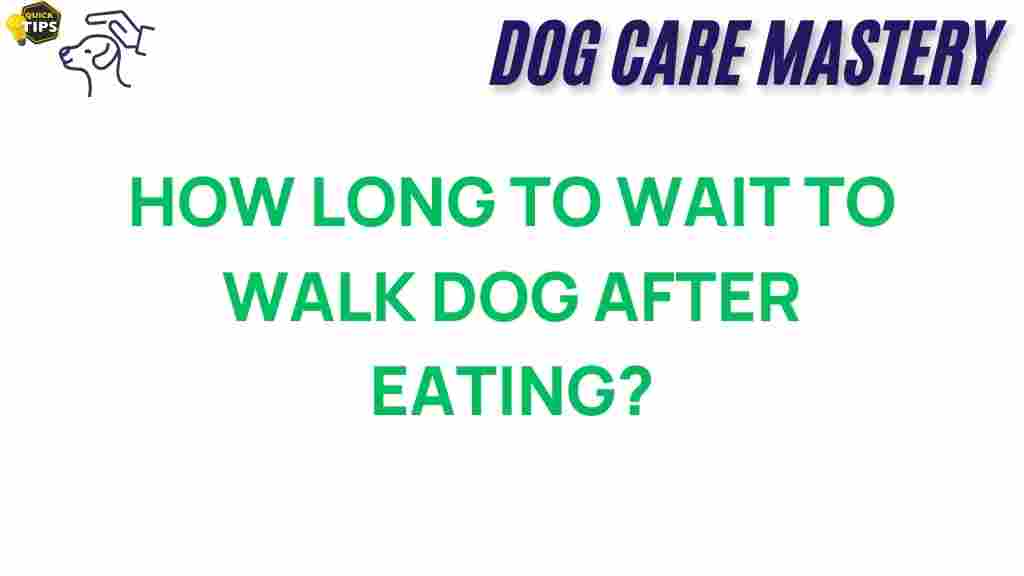The Hidden Dangers: How Long to Wait to Walk Your Dog After Eating?
When it comes to dog walking, many pet owners overlook a crucial aspect of their dog’s health: the timing of walks in relation to meals. It’s easy to assume that as long as your furry friend has had their food, it’s safe to take them out for some exercise. However, walking your dog immediately after eating can pose serious health risks. In this article, we will explore the hidden dangers associated with walking your dog after meals and provide guidance on the appropriate waiting times.
Understanding the Risks
Before we dive into how long to wait to walk your dog after eating, it’s important to understand the potential risks involved:
- Bloat: One of the most serious conditions is gastric dilatation-volvulus (GDV), commonly known as bloat. This life-threatening condition can occur when a dog exercises shortly after eating.
- Digestive Issues: Walking your dog immediately after eating may affect their digestion, leading to discomfort or even vomiting.
- Increased Anxiety: Some dogs may become anxious or excited when walked right after meals, which can exacerbate digestive issues.
How Long to Wait to Walk Your Dog After Eating?
The general consensus among veterinarians is to wait at least 30 minutes to 2 hours after your dog has eaten before taking them for a walk. The exact time can depend on several factors:
- Size of the Dog: Larger breeds are more susceptible to bloat, so they may require a longer wait time compared to smaller breeds.
- Age of the Dog: Puppies and older dogs may have different digestive needs and may require specific timing.
- Type of Food: Dry kibble may digest differently than wet food or homemade meals, influencing how long you should wait.
Step-by-Step Guide to Timing Your Dog Walks
To ensure the health and safety of your dog during walks, follow these steps:
- Monitor Feeding Times: Keep a consistent feeding schedule for your dog. This helps you anticipate when they will need to go out.
- Observe Your Dog: After your dog eats, monitor their behavior. If they seem restless or anxious after 30 minutes, you may consider a gentle indoor play session instead of a walk.
- Wait at Least 30 Minutes: As a rule of thumb, wait at least 30 minutes before taking your dog for a walk. This allows some digestion to occur.
- Evaluate Activity Level: If your dog has eaten a large meal, consider extending the wait time to 1-2 hours, especially for large breeds.
- Start Slowly: When you do go for a walk, start with a slow pace. This helps your dog ease into the activity without straining their stomach.
When Is It Safe to Walk Your Dog?
To determine the best time to walk your dog, consider the following:
- Post-Meal Period: As mentioned, a minimum of 30 minutes after meals is advisable, with longer waits for larger breeds.
- Watch for Signs: If your dog is showing signs of discomfort, such as pacing or whining, give them more time before walking.
- Consult Your Veterinarian: If unsure, a quick chat with your vet can provide personalized advice based on your dog’s breed, age, and health.
Troubleshooting Common Concerns
If you find yourself struggling with your dog’s routine around meals and walks, here are some troubleshooting tips:
- Try a Slow Feed Bowl: If your dog tends to eat too quickly, consider using a slow feed bowl to help them digest better.
- Adjust Meal Portions: Split larger meals into smaller portions throughout the day to reduce the risk of bloat.
- Keep Walks Short Initially: If you’re unsure about your dog’s comfort level, start with shorter walks and gradually increase the duration.
- Indoor Activities: On days when you’re pressed for time or if the weather is bad, consider indoor play sessions to keep your dog active without the risks associated with walking after eating.
Conclusion
In conclusion, being mindful of when you take your dog for a walk after eating is essential for their health and well-being. By understanding the risks associated with immediate exercise, waiting for at least 30 minutes to 2 hours can help prevent serious health issues, especially in larger breeds. Always pay attention to your dog’s behavior and consult your veterinarian if you have any concerns.
For more tips on dog walking and ensuring a healthy lifestyle for your pet, stay informed and proactive. Remember, a well-timed walk is just as important as the walk itself!
For information on canine nutrition and health, check out this helpful resource.
This article is in the category Behavior and created by dogcaremastery Team
